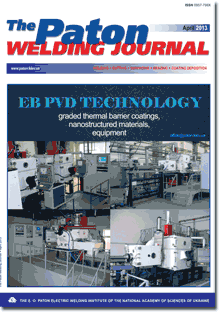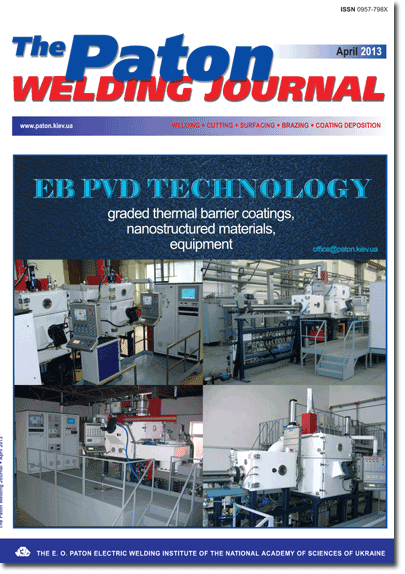
The Paton Welding Journal, 2013, #4, 21-25 pages
E.O. Paton Electric Welding Institute, NASU, Kiev, Ukraine
Abstract
The article is dedicated to investigation of the process of arc brazing on thin-sheet steel 08kp (rimmed) by using brazing filler alloy BrKMts 3-1. Peculiarities of spreading of the filler alloy under conditions of tungsten-electrode arc heating using different shielding atmospheres are considered. It is shown that the best spreading is achieved in a mixture of argon with 10 wt.% of hydrogen. Heat input in arc welding and brazing was compared by the calculation method: the values of heat input (for a specific case) were 1200 and 516.7 J/cm, respectively. The possibility of decreasing the heat input by using the pulsed process is shown. Peculiarities of formation of butt and overlap joints are revealed. In brazing of the butt joints the gap can be adjusted over wide ranges (0.2-0.8 mm), and in brazing of the overlap joints this parameter is within the narrower ranges. However, in general the use of the overlap joints seems more promising. As seen from the data of optical microscopy and X-ray spectrum microanalysis, a silicide interlayer forms at the interface of the joint, where the content of silicon may exceed 10 wt.%. Structure of the seam is a solid solution with discrete precipitates of the phase with the increased silicon content along the grain boundaries. It is shown that in brazing under optimal conditions the strength value of the butt joints on low-carbon steel brazed by using filler alloy BrKMts 3-1 is 330-390 MPa. In the overlap joints the full strength value is achieved at an overlap equal to thickness of the materials joined. 11 Ref., 8 Figures.
Keywords: welding, arc brazing, low-carbon steels, brazing filler alloy, shielding atmosphere, spreading of brazing filler alloy, coating, strength of joints
Received: 05.02.13
Published: 28.04.13
References
1. (1999) WIG-Loeten verzinkter Bleche. Bleche Rohre Profile, 46(7/8), 16.
2. Tischter, F. Verfahren zum MSG-Loeten und Verwendung eines Schutzgases: Appl. 19952043, Germany. Int. Cl. B23K 3/04, B23K 1/08. Fil. 28.01.1999. Publ. 03.05.2001.
3. Knopp, N., Killing, R. (2004) Hartloeten verzinkter Feinbleche mit dem Lichtbogen sicher und wirtschaftlich: Teil 2. Der Praktiker, 1, 8-12.
4. Hackl, H. (1998) MIG-Loeten von verkzinten Duennblechen. Technica (Suisse), 47(25/26), 54-58.
5. Hackl, H. (1998) MIG-brazing of galvanised thin sheets and profiles. Welding and Cutting, 50(6), 102-104.
6. Hackl, H. (2001) Loeten statt Schweissen steigert Qualitaet von PK WS Stahlmarkt: Informationen ans Stahlindustries. Stahlhaldel und Verarbeitung, 51(1), 68-69.
7. Hackl, H. (2000) Loeten statt Schweissen. Bleche Rohre Profile, 47(12), 110.
8. (2003) Verzinkte Bleche MIG-Loeten. Ibid., 50(1), 24-25.
9. Hackl, H. (2002) Beim MIG-Loeten eruebright sich das Nachverzinken. Ind.-Anz., 124(23/24), 38-39.
10. Grzybicki, M., Jakubowski, J. (2009) Comparative tests of welding of sheets made of car body steel using the CMT and MIG/MAG methods. Przeglad Spawalnictwa, 10, 32-36.
11. Rozanski, M. (2010) Modern weldbrazing methods. Ibid., 9, 24-28.
AS = «Automatic Welding» - 6 issues per year;
TPWJ = «PATON WELDING JOURNAL» - 12 issues per year;
SEM = «Electrometallurgy Today» - 4 issues per year;
TDNK = «Technical Diagnostics and Non-Destructive Testing» - 4 issues per year.
| 2013 №04 (03) | 2013 №04 (05) |

The Paton Welding Journal, 2013, #4, 21-25 pages
ARC BRAZING OF LOW-CARBON STEELS
V.F. KHORUNOV, I.V. ZVOLINSKY and S.V. MAKSYMOVA
E.O. Paton Electric Welding Institute, NASU, Kiev, Ukraine
Abstract
The article is dedicated to investigation of the process of arc brazing on thin-sheet steel 08kp (rimmed) by using brazing filler alloy BrKMts 3-1. Peculiarities of spreading of the filler alloy under conditions of tungsten-electrode arc heating using different shielding atmospheres are considered. It is shown that the best spreading is achieved in a mixture of argon with 10 wt.% of hydrogen. Heat input in arc welding and brazing was compared by the calculation method: the values of heat input (for a specific case) were 1200 and 516.7 J/cm, respectively. The possibility of decreasing the heat input by using the pulsed process is shown. Peculiarities of formation of butt and overlap joints are revealed. In brazing of the butt joints the gap can be adjusted over wide ranges (0.2-0.8 mm), and in brazing of the overlap joints this parameter is within the narrower ranges. However, in general the use of the overlap joints seems more promising. As seen from the data of optical microscopy and X-ray spectrum microanalysis, a silicide interlayer forms at the interface of the joint, where the content of silicon may exceed 10 wt.%. Structure of the seam is a solid solution with discrete precipitates of the phase with the increased silicon content along the grain boundaries. It is shown that in brazing under optimal conditions the strength value of the butt joints on low-carbon steel brazed by using filler alloy BrKMts 3-1 is 330-390 MPa. In the overlap joints the full strength value is achieved at an overlap equal to thickness of the materials joined. 11 Ref., 8 Figures.
Keywords: welding, arc brazing, low-carbon steels, brazing filler alloy, shielding atmosphere, spreading of brazing filler alloy, coating, strength of joints
Received: 05.02.13
Published: 28.04.13
References
1. (1999) WIG-Loeten verzinkter Bleche. Bleche Rohre Profile, 46(7/8), 16.
2. Tischter, F. Verfahren zum MSG-Loeten und Verwendung eines Schutzgases: Appl. 19952043, Germany. Int. Cl. B23K 3/04, B23K 1/08. Fil. 28.01.1999. Publ. 03.05.2001.
3. Knopp, N., Killing, R. (2004) Hartloeten verzinkter Feinbleche mit dem Lichtbogen sicher und wirtschaftlich: Teil 2. Der Praktiker, 1, 8-12.
4. Hackl, H. (1998) MIG-Loeten von verkzinten Duennblechen. Technica (Suisse), 47(25/26), 54-58.
5. Hackl, H. (1998) MIG-brazing of galvanised thin sheets and profiles. Welding and Cutting, 50(6), 102-104.
6. Hackl, H. (2001) Loeten statt Schweissen steigert Qualitaet von PK WS Stahlmarkt: Informationen ans Stahlindustries. Stahlhaldel und Verarbeitung, 51(1), 68-69.
7. Hackl, H. (2000) Loeten statt Schweissen. Bleche Rohre Profile, 47(12), 110.
8. (2003) Verzinkte Bleche MIG-Loeten. Ibid., 50(1), 24-25.
9. Hackl, H. (2002) Beim MIG-Loeten eruebright sich das Nachverzinken. Ind.-Anz., 124(23/24), 38-39.
10. Grzybicki, M., Jakubowski, J. (2009) Comparative tests of welding of sheets made of car body steel using the CMT and MIG/MAG methods. Przeglad Spawalnictwa, 10, 32-36.
11. Rozanski, M. (2010) Modern weldbrazing methods. Ibid., 9, 24-28.
The cost of subscription/purchase order journals or individual articles
| Journal/Currency | Annual Set | 1 issue printed |
1 issue |
one article |
| AS/UAH | 1800 UAH | 300 UAH | 300 UAH | 150 UAH |
| AS/USD | 192 $ | 32 $ | 26 $ | 16 $ |
| AS/EUR | 180 € | 30 € | 25 € | 15 € |
| TPWJ/UAH | 7200 UAH | 600 UAH | 600 UAH | 280 UAH |
| TPWJ/USD | 384 $ | 32 $ | 26 $ | 16 $ |
| TPWJ/EUR | 360 € | 30 € | 25 € | 15 € |
| SEM/UAH | 1200 UAH | 300 UAH | 300 UAH | 150 UAH |
| SEM/USD | 128 $ | 32 $ | 26 $ | 16 $ |
| SEM/EUR | 120 € | 30 € | 25 € | 15 € |
| TDNK/UAH | 1200 UAH | 300 UAH | 300 UAH | 150 UAH |
| TDNK/USD | 128 $ | 32 $ | 26 $ | 16 $ |
| TDNK/EUR | 120 € | 30 € | 25 € | 15 € |
AS = «Automatic Welding» - 6 issues per year;
TPWJ = «PATON WELDING JOURNAL» - 12 issues per year;
SEM = «Electrometallurgy Today» - 4 issues per year;
TDNK = «Technical Diagnostics and Non-Destructive Testing» - 4 issues per year.

